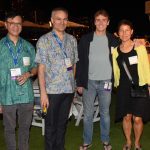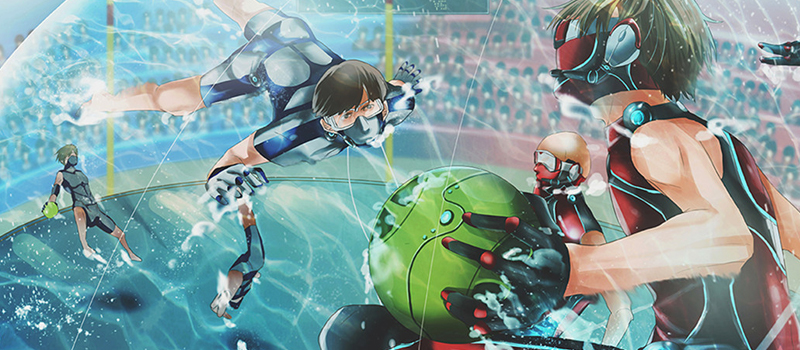
The next wave of ICT will produce major transformation
Ichiya Nakamura, it seems, has had many lives. Now a professor at Graduate School of Media at Keio University, one of Japan’s top academic institutions, he has worked in telecom regulatory issues when Japan’s market was liberalized in the 1980s, and before that, he can even claim a résumé item as manager of Shonen Knife, a Japanese rock band.
After these varied experiences, he has become one of Japan’s foremost commentators on the impact of the new media environment. In an interview for PTC, he discussed the most important ICT issues he sees in Japan—and beyond.
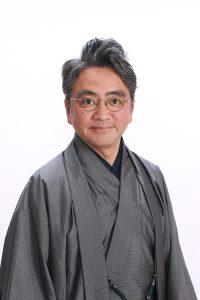
Ichiya Nakamura Professor, Graduate School of Media Design, Keio University Japan
A wearable wave
He is emphatic about one aspect: change is most certainly on the way. But nothing about this change will be incremental.
“A new wave of developments including wearable technology, IoT, and AI is already emerging naturally from the impact of digital technology (essentially PCs, the Internet, and content) over the last 20 years,” he argues, “but [it will be] combined with the ‘smart’ revolution (smartphones, cloud services, and social media) over the last 10 years.”
However, he contends: “This combination will have an even bigger socio-economic impact than the digital and smart revolutions [had separately].”
In his view, the breaking of this wave is now probably imminent. The scale of the resulting transformation will be both unprecedented and underappreciated.
Interpreting the impact in another way, he explains: “The digital revolution made B2C transactions possible, and the smart revolution did the same for C2C transactions. The next major wave of innovation will achieve M2M business.”
It will signal a new social era. “This revolutionary expansion of industry [involving the mass digitalization and networking of industrial processes] is often termed Industry 4.0.”
He continues: “However, the Japanese government calls it Society 5.0, considering the social changes and conversion of civilization that it will bring about as comparable to the hunting, agricultural, industrial, and information revolutions up until now. ICT is the first major upheaval since the Gutenberg Revolution five centuries ago, but IoT and AI are unlike anything that has come before in the 10,000 years since human society first entered the world.”
Towards the Great Reform
The Japanese Society 5.0 concept is described as representing a “Great Reform Age,” where IoT, AI, robots, and life science will drastically change industrial and social structures, he says. This smart society explicitly involves innovation based on major social challenges, such as changing demographics and population trends as well as environmental and security issues.
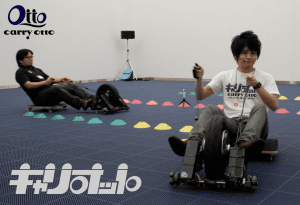
Photo Credit Superhuman sports CarryOtto®
The smart society concept recognizes that some “walls” to progress will exist. As well as transforming legal models, planners recognize it is important that social acceptance and buy-in takes place for the innovation to occur. Even so, the arrival of innovation will be disruptive to many ways of organizing society, he says, as the capabilities of AI take hold in the medium term to facilitate this transformation.
Particular economic sectors could see radical change. For example, the arrival of self-driving vehicles—one key component technology for this era—may cause widespread unemployment in the haulage and transportation industries. However, he says he is “optimistic” overall about outcomes, expecting new employment opportunities to emerge from the technologies on offer.
Wanted: new policies
In all of this upheaval, what should policymakers do? Past communications regulatory approaches such as the telecom market liberalization measures seen in Japan and elsewhere in the 1980s were relatively successful, he says, and achieved the creation of consumer choice and innovation. Japan—for example—now sees three major telecom infrastructure providers where only one existed before.
But this past ICT policymaking was both complex and often relatively technical in scope. Moreover, communications and carriage services have been generally regulated in quite different ways to content services. Prof. Nakamura indicates the landscape has changed dramatically. We already see the capacity of the Internet to create major new players in the marketplace. The G-A-F-A (Google, Apple, Facebook, Amazon) entities carry power and connectivity that goes “beyond national borders,” he argues. This means that “ICT is now [ultimately] calling into question the relationship between countries and companies,” he adds.
He acknowledges that the dominance of the new players presents policymaking with challenges that no government in the world has yet solved. There is, he admits, very little guidance on what new regulatory principles could be, but he says, “We should move from industry regulation [approaches] of the past to protecting users.”
Specific technologies could also cause major impact at national level. For example, he says, blockchain technology could potentially divide up the function of a country among individuals. It may enable very strong P2P linkages to be formed. On the other hand, machines could exceed the potential of human beings with AI, making it necessary to reconsider the interactions between people and organizations, communities, and technology in a fundamental way. Further off, he acknowledges that eventually, a singularity may occur—some have suggested 2045 as the time when the aggregate capability of AI will surpass human capability. But that is another policymaking challenge.
The new users
As might be expected given his unusual background, Prof. Nakamura’s own research interests are varied and expansive. Several focus on the content interactions that users make with systems, or issues surrounding the use of media by children as well as adults. A notable feature of his work is that users get to create their own environments using technology platforms and tools. Participatory involvement through games and challenges is demonstrated on a human-centered level. Fun is emphasized, especially in projects such as Canvas, an ICT learning community targeted at children.

Photo Credit Team BJ
“My research projects relating to media fusion, digital kids, and pop power have all sought to create new business and culture through digital technology,” he says.
Another driver is to look at adequate time horizons over which technologies will impact. The near-term outlook is relatively predictable, he says. “The ‘smart’ revolution is reaching maturity while AI and IoT technology progress simultaneously as a harmonious whole.” But whilst the shift to Society 5.0 will begin in the 2020s, “the emergence of AI and IoT demands a larger-scale project with a longer-term perspective.”
In the meantime, some sense of what could happen needs to be envisioned. “It’s difficult to picture a clear image of what this project would entail right away. For this reason, the Contents Innovation Program (CiP), which will create a special district in Japan where new visions and activities are shared, is progressing first. This will be a space where you can experience the fusion of new technology and culture, and it will be opening in Tokyo in 2020.”
This demonstration zone will be exhibited as a showcase at the 2020 Tokyo Olympics. “The 1936 Berlin Olympics showcased radio, the 1964 Tokyo Olympics showcased TV, and the 2012 London Olympics showcased the Internet [and social media],” he says. “The next Olympic Games in Tokyo will showcase 5G, 8K [HDTV], VR, AR, Big Data, AI, IoT, and blockchain technology.”
He is also inaugurating major education initiatives in the same timeframe. “I am currently working on a plan to open an ICT vocational college—iUniversity—in Tokyo in 2020. iUniversity will link students with ICT companies to train the ICT business leaders of the future. I want to make it an education and research institution that links ICT professionals all over the world through the Internet.”
The superhuman arrives
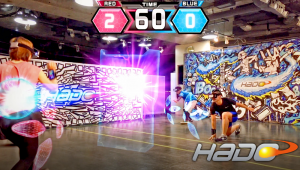
Photo Credit meleap inc.
Alongside all of this, he is keen to see a wide-ranging mix of pop culture and high technology and has set up various initiatives to cleverly mix the two. One particularly intriguing idea—the Superhuman Sports Society—combines new ideas for competitive sports with ICT, often in a Japanese manga-style environment drawing from prototypical superhero characters. Inspiration has come from a wide variety of sources from quidditch of the Harry Potter worlds to Dragon Ball Z. Elements of local culture are also often incorporated alongside established Japanese game approaches.
As with his other projects, the place of the individual is emphasized. The new sports contests occupy both real and virtual spaces; contestants may don special suits with augmented motors and sensors, or be given motive power in intelligent carts, or use robotics or drones mixed in with virtual reality. In many of the new “sports,” the augmentation is also designed to support people with disabilities. The result is a kind of human-powered Robot Wars but one which takes place on a human-centered and augmented level. Since launch, 12 new “sports” have been certified.
The resulting fusion of possibilities is a heady, inspiring cocktail of what might be.
We may be heading for a disruptive time, but if Ichiya Nakamura’s efforts are representative, there seems no shortage of ideas and possibilities to enable ICT to make global life better—and in a literal way, more empowered—for everyone.
Professor Ichiya Nakamura will be one of our highlight presenters at PTC’18 during the Tuesday Morning Keynotes on 23 January 2018.



